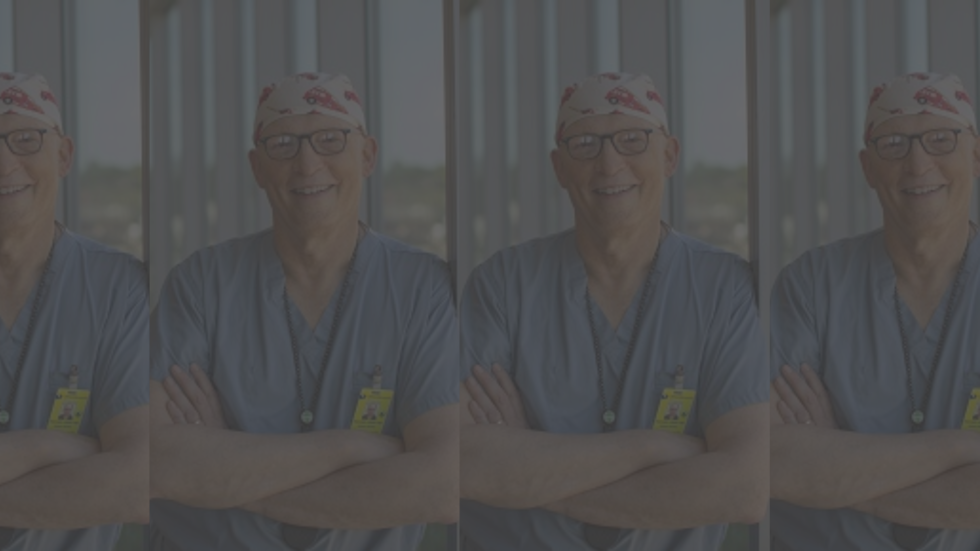
UMass Memorial Medical Center Chief of Pediatric Surgery Michael Hirsh’s parents were both Holocaust survivors. They had been in a concentration camp in Holland, where his mother was trained as a nurse.
“She passed away in 2021 at the age of 97, but she was the best diagnostician I’ve ever met,” Hirsh said. “And I’m sure, had she been born in a different time, under different circumstances, she would have become a physician.”
Hirsh recalled seeing his mother head off to work in her white uniform, and occasionally drove with his father to drop her off for her night shift. At a young age, he observed and was inspired by some of the doctors at the hospital, creating his own little piggy bank with a taped sign that read, “For My Doctor’s Business.”
“So I think it was ordained that [medicine was] what I was going to do,” Hirsh added. “I don’t recall my parents pushing me in that direction. It just was something that I thought would be the best way for me to make a contribution.”
Undergraduate and Medical School Years
As a native of New York City, Hirsh had always dreamed of going to Columbia University, where he ultimately attended for his undergraduate years. He was a part of the rowing team, and though he joked that they were the “worst crew in the Ivy Leagues,” he had a wonderful experience and loved the people on his team.
Hirsh’s entire class only consisted of 900 students, which made his experience very intimate. He remembered being slightly intimidated by the amount of students who showed interest in the pre-med track, but knew that he wanted to pursue medicine.
Hirsh initially chose to major in biology, which required him to be proficient in two languages other than English. He had grown up with extensive French instruction, and had placed out of that language, and so the second language he chose to study was German.
“I chose to take German, which was the native tongue of both of my parents, although they never spoke it to me [and] they didn’t raise me bilingually,” Hirsh said. “But I was kind of fascinated by that, and so doing, it opened up a whole world of liberal arts. They had a very interesting, very highly intellectually stimulating department.”
Towards the middle of his second year, Hirsh switched to a pre-med major, which allowed him to have less requirements to fulfill, apart from all of the standard pre-med requirements. So, he became a pre-med and German double major, a choice that made a huge difference in his college experience.
Hirsh’s experience at Harvard Medical School, however, was initially much less welcoming than Columbia, especially towards Jewish students. His first year in medical school was so much of a struggle that he almost transferred to Columbia Medical School.
“But my parents and some other very important influences in my life urged me to ride it out, which I did,” Hirsh said. “And eventually I found my group of friends, and we were all kind of anti-Harvard.”
During one of his clinical rotations at Beth Israel Deaconess Medical Center, Hirsh met his wife of 44 years, who was a nurse at the hospital and became one of the biggest influences on his life. As a Western Massachusetts native, she loved the city, and she very much “changed [his] outlook on Boston,”
A Turning Point
When Hirsh was younger, he was stabbed at school and taken to Columbia Presbyterian Hospital. He had been thoroughly impressed by how the trauma team had treated him, which was a big influence on why he decided to attend residency at that very same hospital.
The area surrounding Columbia Presbyterian was very violent, their patient population was “volatile and dangerous,” and residency was like being in the military, according to Hirsh. However, his biggest turning point was when his best friend John Wood was shot and killed in the emergency room by a 15 year old.
Hirsh took matters into his own hands to bring justice to this case. The day after his friend was murdered, he held an open mic session for all the hospital staff to “come and vent” their sorrow about the murder. Wood’s death had hit the medical community very hard — according to Hirsh, he was a very influential and legendary person, and “there wasn’t anybody that didn’t know him.”
“It was the best of times, it was the worst of times … the pain of losing my friend has never left me to this day,” Hirsh said.
Following the open mic session, Hirsh’s chairman of surgery asked him for feedback surrounding the general environment of the residents’ workplace. To that, Hirsh responded that the residents wanted to quit — no one was coming forward to identify the murderer, patients were frequently carrying around knives and guns, and it was a tremendously unsafe place to work.
“We didn’t employ metal detectors, our security guards were all elderly, retired cops that were unarmed, so they really couldn’t intercede if there was a gang thing going on,” Hirsh said. “We had a very poor salary, so we couldn’t afford to be anywhere but just around just where we were all living.”
The beginning of gun safety advocacy
After listening to Hirsh’s words, the chairman requested that Hirsh gather the community together one more time to speak about the murder. So, Hirsh booked out a famous vaudeville jazz club called the Audubon Ballroom — the location where Malcolm X was assassinated.
Sarah Brady, the wife of President Ronald Reagan’s Press Secretary Jim Brady, spoke at the event. When Reagan was shot during an assassination attempt, Jim Brady had taken a bullet to the brain and was severely debilitated. Though Jim Brady lived another 40 years, he was never the same.
So, Sarah Brady led the effort to start the Brady Campaign, an organization that Hirsh noted was a leading voice in gun violence prevention. A key thing she spoke of during the event was the idea that interpersonal violence is caused by a variety of factors — poverty, racism, or lack of education.
“The one thing that makes all of those violent episodes elevate to lethal episodes is the firearm,” Hirsh said. “And Brady said limiting access to the firearm, what she called ‘lethal means reduction’, was in her mind a critical thing that we had to do moving forward.”
Sarah Brady’s words resonated with Hirsh, and it was at that point that he began to take actions to make Columbia better. He spoke with the head nurse in the emergency department, coordinating with the hospital to enact several changes that greatly increased the safety of their working environment.
For example, every patient admitted into the emergency department was required to strip off all of their clothes and change into a hospital gown, and Hirsh couldn’t believe the amount of weaponry they collected. Then, before returning the weapons back to the patients, they presented them to the hospital board of trustees.
“I had my surgical residents wheel gurneys of weapons into the room, and I said, ‘This is what we are facing every day: our population is armed and dangerous,’” Hirsh said. “‘And we’re not protected.’ And I think it had the desired impact.”
This led Hirsh to eventually co-found Goods For Guns, where they gave money to people who traded in their unwanted firearms. Since its inception, the organization has collected up to 13,000 guns in Pittsburgh since 1994 and 4,200 guns in Worcester since 2002.
“But it’s not just the number of weapons — it’s really been always the awareness that we try to bring … about a gun in the home,” Hirsh said. “And if you have additional elements that raise that risk, like an angry spouse, demented, elderly person, a depressed teen, inquisitive toddler, somebody with substance use disorder, all of these things elevate the risk of that gun.”
A Career in Pediatric Surgery
As a pediatric surgeon, Hirsh deals with babies born with anatomical birth defects. He noted that his role eventually evolved into a primary care perspective, given that he enjoys maintaining a long term relationship with the family.
Hirsh specializes in pediatric trauma surgery, a subsection he enjoys not because it is necessarily enjoyable, but because it is a neglected area of pediatric surgery. According to Hirsh, pediatric trauma is the number one killer of kids by a significant factor.
Given that approximately 95% of the injuries he was operating on were preventable, became the co-director of the Injury Free Coalition for Kids, a consortium of injury prevention centers with over 60 sites around the country. Through the coalition, physicians led programs that included installation of car seats, helmet programs for sports, and gun buybacks.
“We worked with first time driving offenders who had been brought in by the court system in our hospital for a day,” Hirsh said. “And we tried to shake them up by showing them some of the consequences of the bad decisions they had made, whether it was drunk driving, speeding, [and] distracted driving.”
The coalition became an integral part of many pediatric surgical centers, which has made tremendous strides in lowering the number of pediatric traumas. However, Hirsh noted that pediatric suicide and homicide rates are still increasing, especially due to the mental health issues caused by the pandemic.
“At one time, if you were a child under 18 and you had a gunshot wound, it was two thirds likely that it was suicide and one thirds likely that it was homicide,” Hirsh said. “Now it’s fifty-fifty. This is a big problem — a big problem.”
While having a discussion with his daughter, Hirsh told her that there is “no higher high” compared to saving a person’s life. Hirsh added that the act of saving a life does not have to be dramatic, such as performing an operation or running to the emergency room. Specifically, many of the internal, family, and pediatric practitioners save lives in a more deliberate, long-term way.
“You may have turned a patient around from a bad behavior, or from becoming obese, or having an eating disorder … and you’ve saved their lives,” Hirsh said.
Though many residents and medical students going through modern day medical education are very unhappy about the amount of screen time they spend during their work, Hirsh said that it is valuable to keep in mind that healthcare workers are still performing noble deeds.
“You have to stop and smell the roses every once in a while, and say, ‘I did that, I participated in something that saved a patient’s life,’” Hirsh said. “There’s nothing like that — in my opinion, there’s no feeling as high as that.”




